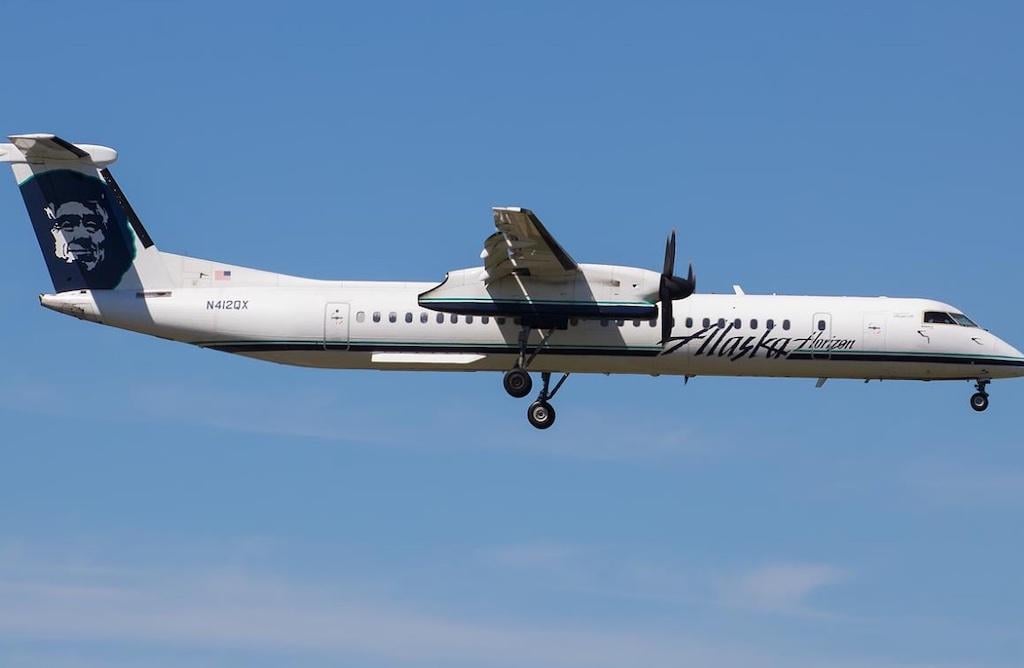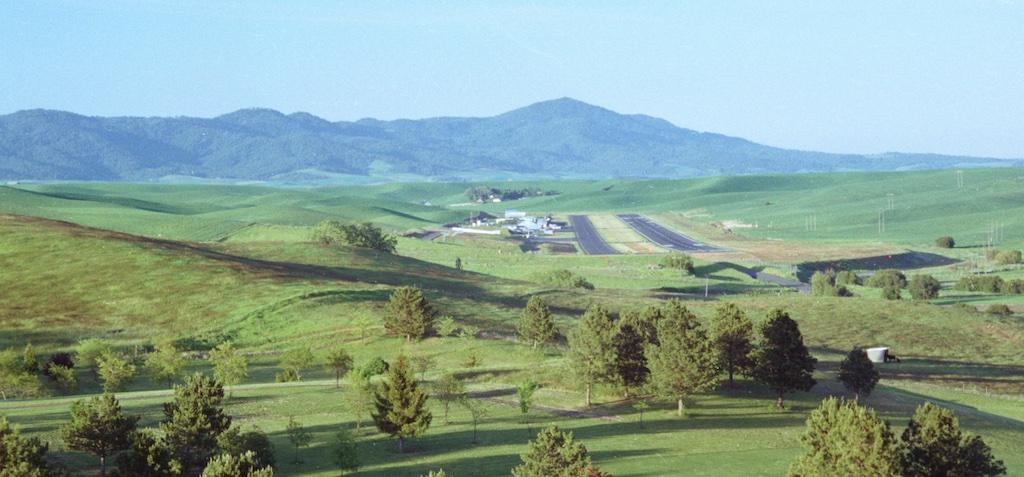
The DHC-8-402, registration N412QX, shown in flight.
When an airplane lands at the right airport but on the wrong surface, one of the possible wrong surfaces is a parallel taxiway. One of those taxiway landings took place at Pullman/Moscow Regional Airport (PUW) in Pullman, Washington on Dec. 29, 2017, when a Horizon Air DHC-8-402 landed on the taxiway adjacent to Runway 6.
Like the two Learjet wrong runway landings at Chicago and Jeffersonville, Indiana, this one took place in darkness at an uncontrolled airport. Unlike those accidents, there was no damage to the airplane and there were no injuries to the crew or passengers.
The lighting for Runway 6—the only runway—was inoperative, but no NOTAM had been issued. Airport officials said they tested the runway lights about two hours before the incident but somehow, they didn’t notice that the lights were not working. A company employee on the ground assigned to monitor and report traffic to the inbound crew also failed to notice that the runway lights were not on. Thus, the stage was set for a mistake to be made.
The flight was a scheduled passenger flight operated under Part 121; it originated at Seattle/Tacoma International Airport in Seattle, Washington.
The terminal aerodrome forecast (TAF) for PUW called for IFR conditions, with winds predicted to be 070 degrees at 3 kt., 3 mi. visibility, light rain, mist, and broken and overcast cloud layers as low as 600 ft. The actual conditions, reported by a METAR 13 minutes after the airplane landed, were winds 150 deg. at 10 kt., 5 mi. visibility, light rain and mist, with the lowest cloud deck a broken layer at 3,000 ft.
The stretched Dash 8, commonly known as a Q400, was equipped with a Head-up Guidance System (HGS) display on the captain’s side and the airline expected pilots to use it.
The crew was cleared for and flew a company-tailored approach, the RNAV (RNP) M instrument approach to Runway 6. The approach provided vertical guidance, with the RNP minimum altitude 2,858 ft., or 320 ft. above the ground. Following the vertical guidance, the airplane would cross 57 ft. above the runway threshold. The chart noted that the runway had REIL lighting and a PAPI on the left side of Runway 6, and that pilot-controlled lighting could be activated on the PUW Unicom frequency. There were supposed to be high-intensity white runway edge lights and green threshold lights.
Just after passing the initial approach fix, which was 11.8 nm from the runway, the airplane broke out of the overcast and the captain saw lights at the airport. He couldn’t determine if the lights were bright or dim, and he triggered the CTAF frequency several times to see if it changed the brightness. He saw no change. He said in an interview that he clearly thought he had the runway in sight. The runway lights were on, but not going to a bright position. As he approached the runway, the captain saw nothing but black straight ahead but lighted pavement to the left and he “slid the airplane over to line up with the illuminated pavement.”
The first officer (FO) noticed the edge lights were blue as the aircraft flared. He said, “this is a taxiway,” but they were already touching down. The pilots rolled out to the end of the taxiway, back-taxied on the runway and went to the gate.
Both pilots saw the PAPI lights early in the approach and both said they were on the glide path, but neither recognized that the PAPI should have remained to their left as they landed. The captain did not discuss the expected lighting configuration during the approach briefing.
PUW officials later discovered that runway wiring vaults were flooded, probably as a result of heavy rain and snow the previous day. The airport re-oriented the runway and installed an ILS approach two years later.
NTSB accident investigators obtained the cockpit voice recorder but most of the data was corrupted, so they were unable to document the crew’s exact remarks. They flew a simulator with an HGS to try to duplicate what the pilots saw, but the report they wrote was inconclusive. The HGS is very precise for Cat III approaches, but it didn’t appear to be much help to this flight crew at the last minute on the RNAV approach.
The safety board declared the probable cause of the incident was “the flight crew’s misidentification of the taxiway as the landing runway due to the failure of the runway lighting that caused only the taxiway lights to be illuminated.”
Lessons Learned

https://commons.wikimedia.org/wiki/File:MoscowPullmanAirport.jpg
As was the case with the two Learjet crews, there was a big disparity in the age and experience of the two pilots. The 49-year-old captain had 13,528 flight hours, including 5,997 hours on the Q-400. The FO, age 38, had 1,582 hours with 95.5 hours in the Q-400. He had been hired only five months before the incident.
The FO told investigators that he held ATP and CFI certificates but had failed his initial attempts to obtain his instrument rating and multi-engine certificates. He had some difficulty in his training at Horizon Air, having been unsuccessful in his first maneuvers validation check and his first line check. After receiving additional initial operating experience (IOE), he completed his initial line check on Dec. 24, five days before the incident.
Having to identify the wrong light configuration and command a go-around was a heavy responsibility for a new FO on his second live flight after IOE. Briefing the runway markings and light configuration could have helped him recognize the problem sooner.
I see two takeaways from the three wrong pavement landings discussed in this series. First, making visual approaches at night carries extra risk, especially if there is no tower. Making use of an ILS or RNAV glide path when available would reduce risk. This was the policy of my old Air Force command, and it’s the policy of at least one well-respected fractional ownership operator as well.
Second, what exactly the pilot monitoring (PM) is supposed to monitor is often left to the pilot’s discretion, and it shouldn’t be. PM responsibilities don’t happen organically. They need to be taught. As more new co-pilots arrive in your operation, the PM preparation needs to increase. That goes for captains as well as FOs.
Parsing A Runway Excursion At Chicago Executive: https://aviationweek.com/business-aviation/safety-ops-regulation/parsin…
Revisiting Another Wrong Runway Landing, https://aviationweek.com/business-aviation/safety-ops-regulation/revisi…






Comments